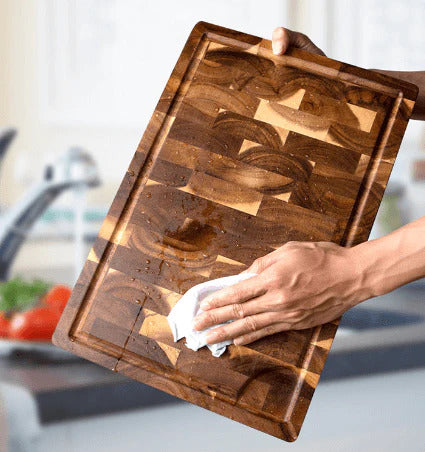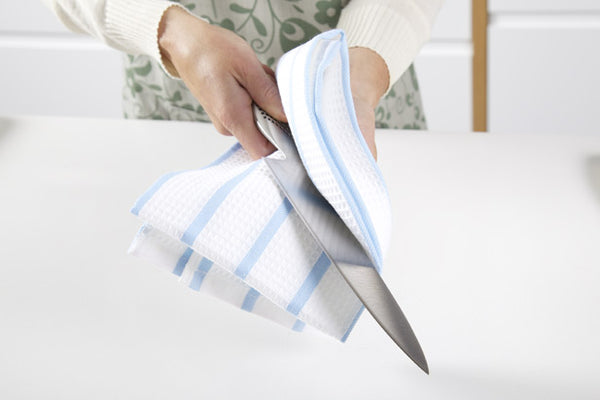One aspect of caring for your knives is maintaining the edge and, when needed, sharpening the blade . But it's also important to be aware of how you're using your knives on a daily basis. The instructions below will guide you through the process of how to properly care for and maintain your knives.

Cutting Surface and Cutting Technique
The cutting surface you use makes a big difference in keeping your Japanese chef knives sharp. A good cutting board will help retain a sharp edge for substantially longer. Wood boards are excellent choices, while tile, ceramic, marble, granite or any kind of glass cutting boards are poor choices and are very hard on your knives.

Shop Best Cutting Board to Preserve Your Knife's Edge →
The best hard surfaces have tough, durable materials that can withstand daily use and won't dull your blade. Look for a waterproof, antibacterial cutting board—these reduce the risk of illnesses and bacterial growth on your carbon steel knife. Good cutting boards are also easy to clean and require nothing but soap and water.
To protect your knife, you should never use it for anything but cutting food. Opening metal cans, cutting plastic, slicing metal and chopping wood could permanently damage the blade. Your knife could also bend or crack under extreme stress. Similarly, make sure you're using each knife for its intended purpose, and don't use delicate blades to hack through tough materials.
Seido knives are designed to be used in a smooth, slicing motion and never in a forceful, up-and-down "chopping" manner. The proper cutting motion is a "locomotive" motion, pushing the knife forward and down as you cut through the food, then pulling the knife up and back towards you (in order to position it for the next cut). This motion is also similar to cutting wood with a handsaw—forward and down, then back. The razor-sharp Japanese blade makes this practically effortless.
When you first begin using a Seido knife, go slowly and enjoy the precision cutting ability of your new kitchen cutlery. As you gain experience, you will be able to work more quickly. No matter what your experience level, you have to be careful and must always pay attention to where your fingers are in relation to the knife.
You can use your Seido Chef knives on meats and vegetables but not on bones. For very thick-skinned vegetables or heavier kitchen work, try to use our cleaver Knives. A chef cleaver knife is designed to handle more aggressive work in the kitchen, such as breaking down chickens, hacking through bone and preparing thick-skinned vegetables like butternut squash or melons.

Cleaning and Storage
As with any lifetime investment, it's important to take the best care possible in order to prolong the life of your knife. We recommend that you protect your investment by handwashing your blades with warm water and gentle dish soap. Don't use soaps with citrus extracts or bleach because they can promote corrosion. Rinse and towel dry immediately, then let the knives air dry for a few minutes before returning them to storage. You should also never leave your knife sitting in a sink full of soapy water because it does metals no good to be submerged in water for prolonged periods of time, and it's a danger to you when you reach in.

Micro-corrosion, which can result in tiny chips or missing pieces in your knife's cutting edge, can occur because moisture is left on the cutting edge. Moisture weakens stainless steel knives and promotes micro-corrosion. If moisture is left on the cutting edge repeatedly, even normal use in the kitchen can result in small chips in the weakened sections of the edge. To guard against this, wash your knife immediately after use and dry it very thoroughly with an absorbent cloth or towel. Please take extra care to safely dry the sharp cutting edge of your Seido knives, keeping your fingers away from the edge.
After you have washed and dried your knives, we recommend you store them in our stainless steel block, roll-up knife case or in-drawer tray or sheath. We do not recommend storing the knives unsheathed in a drawer, as this can be a potential hazard to the blades as well as your fingers.

Properly Care For Your Knife with this Universal Storage Block →
Honing and Sharpening
In order to maximize the life of the blade, regular honing with knife sharpening tools is recommended. With heavy use, knives can benefit from yearly sharpening. However, weekly honing, although not necessary, is recommended to maintain the razor sharp edge and will extend the time between sharpening significantly.

Sharpening your knives with whetstones can keep a good knife from dulling. Whetstones are blocks made from strong materials, such as diamond, aluminum oxide and ceramic. Coarser grits can repair damaged knives, while finer grits polish your cutlery.
To use a whetstone, soak it in water for 10-15 minutes, and then, clean your knife and sharpen the edge against the stone. Afterward, clean your whetstone and store it in a dry place. This technique sharpens a variety of blades, including Damascus knives, single bevel knives, santoku blades and more.
You could also invest in a professional knife sharper, which is a tool with three or four slots that contain hard materials, such as diamond, tungsten and ceramic. Each slot sharpens, repairs and polishes your blade for high-quality knife maintenance.
Some chefs prefer a sharpening rod for knife maintenance. This is a long, narrow tool with a sturdy handle. You'll grip the handle and sharpen your knife against the rod to revive the dull blade. Afterward, you'll clean and dry the blade before storing it in the knife block.
Washing and Care Instructions
Stainless steel, although stain and rust-resistant, is not impervious to water. We strongly suggest you hand wash and wipe the blade completely dry after each use. Corrosion can occur if food or moisture is left to sit on the blade overnight. The Pakka wood handle, although it is strong, durable, moisture and heat resistant, it is not impervious to water. We recommend you gently wipe the handle under running water with a cloth and immediately dry with a towel but do not soak or leave it submerged in water.
Your Seido knife set is a quality investment piece and by taking the proper precautions you will enjoy many years of stress free service. Again, do not use the knife on hard objects and on surfaces such as tile, ceramic, marble, granite or any kind of glass cutting boards.

Applying Mineral Oil
Whether you're using a sturdy deba knife, a thin gyuto knife or a tough nakiri blade, all Japanese kitchen knives need maintenance to keep rust and patina from developing. Patina is a layer that appears on your knives as they age. While this layer gives your knives extra protection, the discoloration could ruin the appearance.
Applying mineral oil to your carbon steel knives is an essential part of knife maintenance. Make sure you're using a food-grade mineral oil that won't contaminate your ingredients. Once you've chosen a brand, rub a few drops of oil into the knife's blade and handle to create a protective, waterproof shield. Some chefs oil their knives after every use, but oiling them once a month is acceptable.

Maintenance
Please remember that you must re-sharpen the knife blade periodically. If you are using our honing rod/steel, sharpening stone or tungsten sharpener, please keep the correct blade angle while sharpening (8-15 degrees depending on your knife). If you feel the knife snagging a bit, the blade just needs a little stropping or honing, not re-sharpening.



